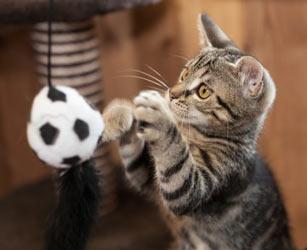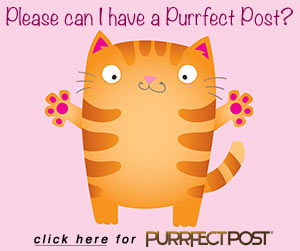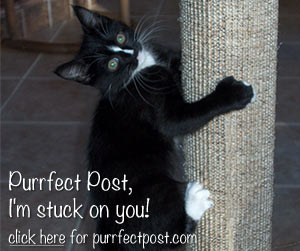Clever DIY Cat Toys

Cats today are usually pampered, indoor members of the family. Their food is handed to them on a regular basis. Cat ancestors had to hunt in order to eat and they did this 10 to 20 times a day. They had the ability to pounce at a moment's notice.
Our modern day felines still possess these predatory instincts. Toys are a great way to help our cats embrace these inherent traits while helping them avoid an owner's leg as a good prey substitute.
Why Does My Cat Need Toys?
- Boredom is a common problem with cats who spend the majority of their time indoors. However, being indoors is the safest place for them, since there are bigger animals, cars, and contagious cat diseases outside. Supplying cats with toys that simulate and mimic their natural behavior will help alleviate the doldrums and prevent unwanted behaviors and anxieties that can develop when cats are bored.
- Obesity is another major health concern of indoor kitties. Toys will offer a way to motivate cats to burn calories and interact more with their humans.
- Fear of change can develop in cats in static environments. Then, any small change in the household can produce stress that can manifest as aggression or negative behaviors. Also, these kitties can develop an unhealthy over-dependence on their owners for stimulation and companionship.
It is important to supply your cat with the correct types of toys to supplement and emulate years of predatory and instinctual habits. In order to do this, the toys must provide visual stimulation or recreate an intellectually similar environment to what it would encounter outside. Most cats prefer a certain type of prey.
Identifying a Cat's Prey Preference Can Be Done Easily
Start by trying toys resembling mice, birds, and bugs. Mice can be represented with something furry and soft, such as a piece of an old terry cloth robe or sock. A feather on a string can represent a bird and a simple knot tied at the end of a string will look like a bug to any cat. Introduce these "creatures" one at a time to your cat by mimicking the natural movement the animal would make. For example, make the "bird" fly through the air and the "mouse" scurry across the floor. Watch your cat's reaction. Alternate the simulated critters every 20 seconds and see which one garners more attention. Some cats will enjoy all of them and will benefit from a variety of "prey." Any toys that feature strings need to be put away out of reach of your cat when you are not supervising. Cats may get tangled up and injured in strings or they may ingest them, resulting in serious intestinal damage.
DIY Toys
Luckily for us, cat toys that provide the required enrichment can be easy to make from items found lying around the house. Some things that may be needed for DIY toys can be purchased for less than the cost of a commercial cat toy. Newspaper, empty water bottles, old socks, and empty cardboard boxes can all be converted into cat toys.
Easy To Make Cat Toys
Here are some DIY toy ideas:
- Crumple up newspaper and attach it with twine to the end of a stick.
- Stuff an old sock with cotton balls and catnip and tie a knot in the end.
- Remove the handle from an empty paper bag to provide a great hiding place and a chance to pounce on anyone who walks by.
- Link several round, hard plastic shower hooks together and then hang them on a doorknob or dangle them from a stick.
- Use non-toxic glue and secure feathers, preferably made from wool, at different increments on a length of fishing line. The fishing line can be attached to a stick or an actual pole. Make the "bird" fly.
- A ping pong ball, or practice golf ball with holes, will indulge a cat's hunting instinct and give visual stimulation. A fun variation on the ping pong ball game is to place one or more inside of an empty bathtub. Cats love to chase the bouncing balls around in a contained space.
- Make a puzzle feeder to excite your cat intellectually. Cut holes in an empty plastic water bottle a little bigger than the size of your cat's kibble. Be sure the holes are not large enough for your cat to get its paw through them and get stuck. Place dry food inside the bottle and place the bottle on its side. The first time this is introduced, make sure there are numerous holes to ensure your cat's immediate success. Subsequent puzzle feeders can have fewer holes. Empty, clean yogurt containers with the lids secured will work for this as well.
- Turn off the lights and have fun with a laser pointer or a flashlight. Make the light move erratically to simulate the way a bug flies. Be very careful not to shine the laser toward your cat's (or anyone else's) eyes because it can cause retinal damage. Learn more here: "Are Laser Pointers Good Cat Toys?."
- Cut the bottom out of 2 large cardboard boxes and secure one to each side of a third box using masking tape. This creates a tunnel effect that cats love and also gives them a hiding place. Make it larger by using more boxes, if desired. Place some crumpled newspaper balls inside for your cat to bat at and chase.
- Make a videotape from a live action nature show featuring birds, fish, and insects. Turn the volume up to easily capture your cat's attention. This is also a great tool to use for those kitties who make mischief when their humans are away.
Rotate your cat's toy collection to keep interest high. Sometimes, a cat will develop a favorite toy and may start sleeping with it or keeping it in a bed or other special place. The message is clear. This toy should be left out of the rotation.
Hazardous Items to Be Avoided on Cat Toys
There are a few things to avoid when making or buying toys for your cat:
- Yarn
- String
- Tinsel
- Dental floss
- Rubber bands
- Plastic (such as the ring from a milk jug) and plastic bags
- Ribbon
- Buttons
- Anything sharp
All of these are safety hazards. If swallowed, strings can become tangled in the intestinal tract and cause serious, life threatening conditions. Plastic can cause mouth lacerations as well as intestinal tract emergencies. Small objects such as buttons, sequins, and "eyes" should not be used for homemade toys and should be removed from any purchased toys for the same reasons.
Appropriate toys enable indoor cats to express their natural predilections as hunters and prevent a myriad of health and behavioral issues as well. Equipping our felines with the correct toys does not have to be a costly endeavor and can be fun project.
You May Also Like These Articles:
How to Play With Your Cat- Part One
How to Play With Your Cat- Part Two
Interactive Playing with Wand Toys
How to Keep Playtime Fun for Your Cat
Keeping Your Cat Active While You\'re Away
Notice: Ask-a-Vet is an affiliated service for those who wish to speak with a veterinary professional about their pet's specific condition. Initially, a bot will ask questions to determine the general nature of your concern. Then, you will be transferred to a human. There is a charge for the service if you choose to connect to a veterinarian. Ask-a-Vet is not manned by the staff or owners of CatHealth.com, and the advice given should not delay or replace a visit to your veterinarian.






